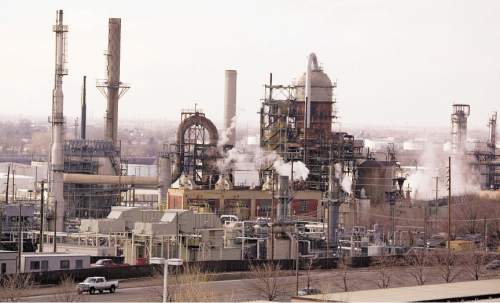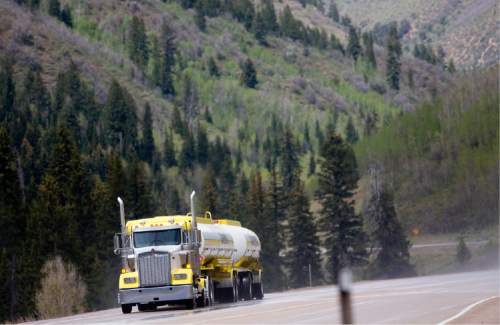This is an archived article that was published on sltrib.com in 2016, and information in the article may be outdated. It is provided only for personal research purposes and may not be reprinted.
When oil prices were strong back in 2014, Darren Snow was a busy man.
The Duchesne County homebuilder had three or four projects stacked up at once. Then the oil bust hit, and his business slowed "to a standstill almost overnight."
Snow is one of several Uinta Basin residents and business owners profiled in a new state report examining the economic impact of oil on this region of Utah that has been swimming in hydrocarbon production, but is now feeling the pinch from a prolonged price slump.
In Roosevelt, sales and transient room tax revenues are off 90 percent, according to the report unveiled Thursday at the annual Waxy Crude Workshop, hosted by the Governor's Office of Energy Development in Duchesne.
"Utah's black and yellow waxy crudes are premier commodities due to their low sulfur content and high API gravities," said workshop host Andrew Sweeney, eastern Utah regional director for the Utah Science Technology and Research Initiative. "But these crudes have limited transportation opportunities due to technical hurdles caused by their unique properties. If we can figure out the science, the economic impact could be tremendous."
Sweeney was referring to Uinta crude's high paraffin content that solidifies at temperatures below 105. This tendency to harden is one reason all the basin's oil production — about 77,000 barrels a day — is moved on trucks, the least efficient way to transport oil.
The report by the Department of Workforce Service's Rural Planning Group highlights the fact that the fortunes of Uintah and Duchesne counties rise and fall on the prices of oil and gas, as well as access to hydrocarbon minerals under federal and tribal lands.
Before the bust, Duchesne enjoyed Utah's highest per-household income, thanks to robust drilling programs and energy investment. But the basin has since lost 2,500 of its 7,000 energy jobs, according to report co-author Kyle Slaughter. Unemployment has since doubled and county revenues plummeted.
"That decreases governmental ability to provide services as expected," Slaughter said. "But the future is not looking too shabby."
Quoting an unnamed "industry insider," the 100-page report said the basin's oil production would be double what it is were it not for Bureau of Land Management regulations.
However, new BLM data indicate Utah oil and gas operators are sitting on 2,124 approved drilling permits, suggesting more is at play than just red tape.
Since 2010, the share of production coming off public lands has decreased, while it has increased on tribal and private lands, the Utah report says. This means local roads see a lot more wear and tear, but counties don't get as much money to cover maintenance.
Utah accounts for just 1.27 percent of U.S. oil production, yet it offers some of the lightest and lowest-sulphur crudes — coveted by refineries because its more easily processed into fuels that meet new federal emission thresholds. It's great for making lubricants, while its gasoline content is rather low.
The five Salt Lake area refineries are equipped for processing waxy crude and within driving distance, allowing them to hold Uinta Basin producers captive and pay them $10 less than the U.S. average. That discount, which translates into a few hundred million in lost revenue, will shrink if Utah can get its oil to other markets.
Thursday's workshop illuminated a path forward. Speaker Mike Roberts' mantra is "pipe-rail-pipe." His firm, 670 LLC, is one of three proposing heated pipelines connecting the oil patch with new rail loadouts in Carbon County. From there, the oil can be shipped east and west on Union Pacific and BNSF Railway lines.
Pipeline proponents believe the ability to move Uinta Basin oil to West and Gulf coast refineries would greatly enhance its value. Already the three loadouts — two at Wellington and one near Helper — have the capacity to load more than two-thirds of the basin's output.
Trucking the crude along U.S. Highway 40 costs $3 to $6 per barrel — a small cut when, according to the Division of Oil, Gas and Mining, oil prices exceeded $100 a barrel. Now, prices bounce around $40 a barrel.
With that drop, production slipped 10 percent last year; just three rigs are drilling in Utah and only seven wells have been started this year.
DOGM's revenues have dried up and it expects to exhaust its reserve fund by the end of the fiscal year, agency director John Baza said. The Legislature provided additional funding for the fiscal year beginning July 1.
"Our responsibilities don't diminish with declines in price and production," Baza said. "During periods of high drilling well counts doubled. We now have 16,000 active wells that have to be continually monitored. We have to ensure compliance."
As for Snow, he has grown used to the basin's economic fluctuations and contends today's downturn is not as severe as those in the past. The builder plans to weather the latest setback by keeping an eye on the long view and making sure his crew members "have the a broad skill set to handle any job that's available."
Brian Maffly covers public lands for The Salt Lake Tribune. Maffly can be reached at bmaffly@sltrib.com or 801-257-8713. Twitter: @brianmaffly





